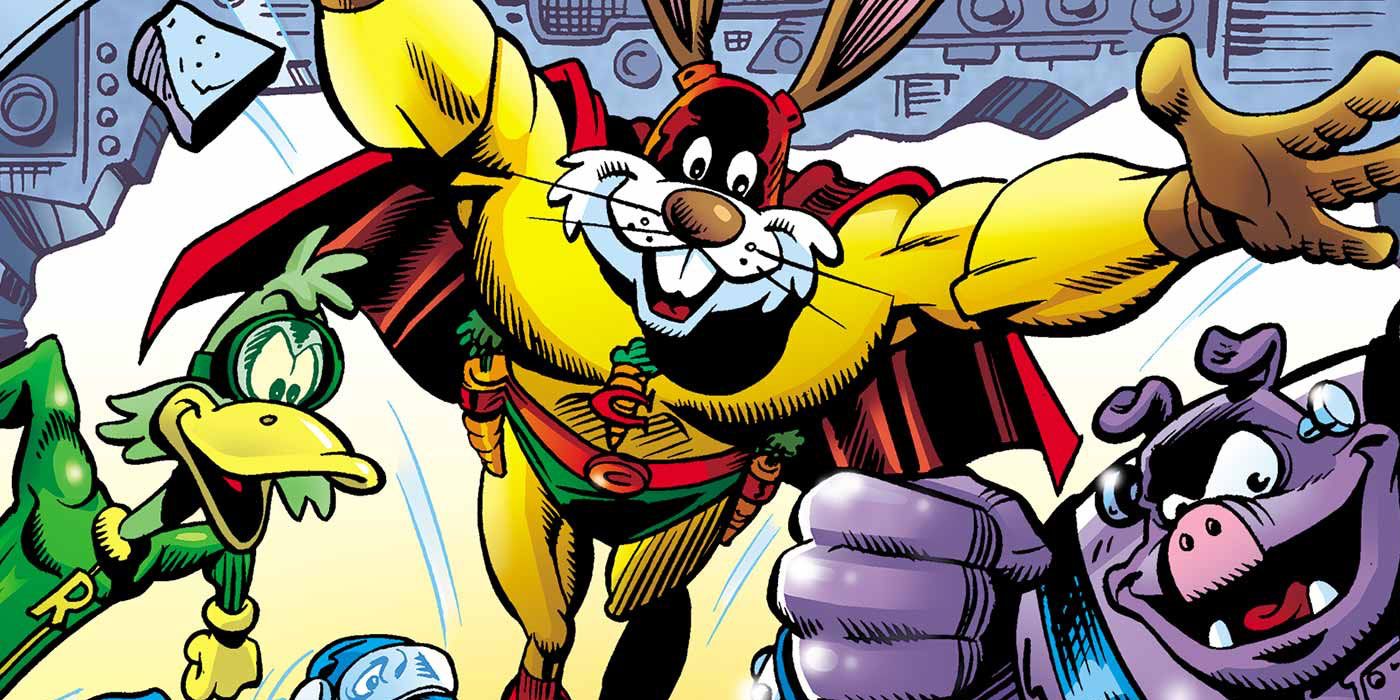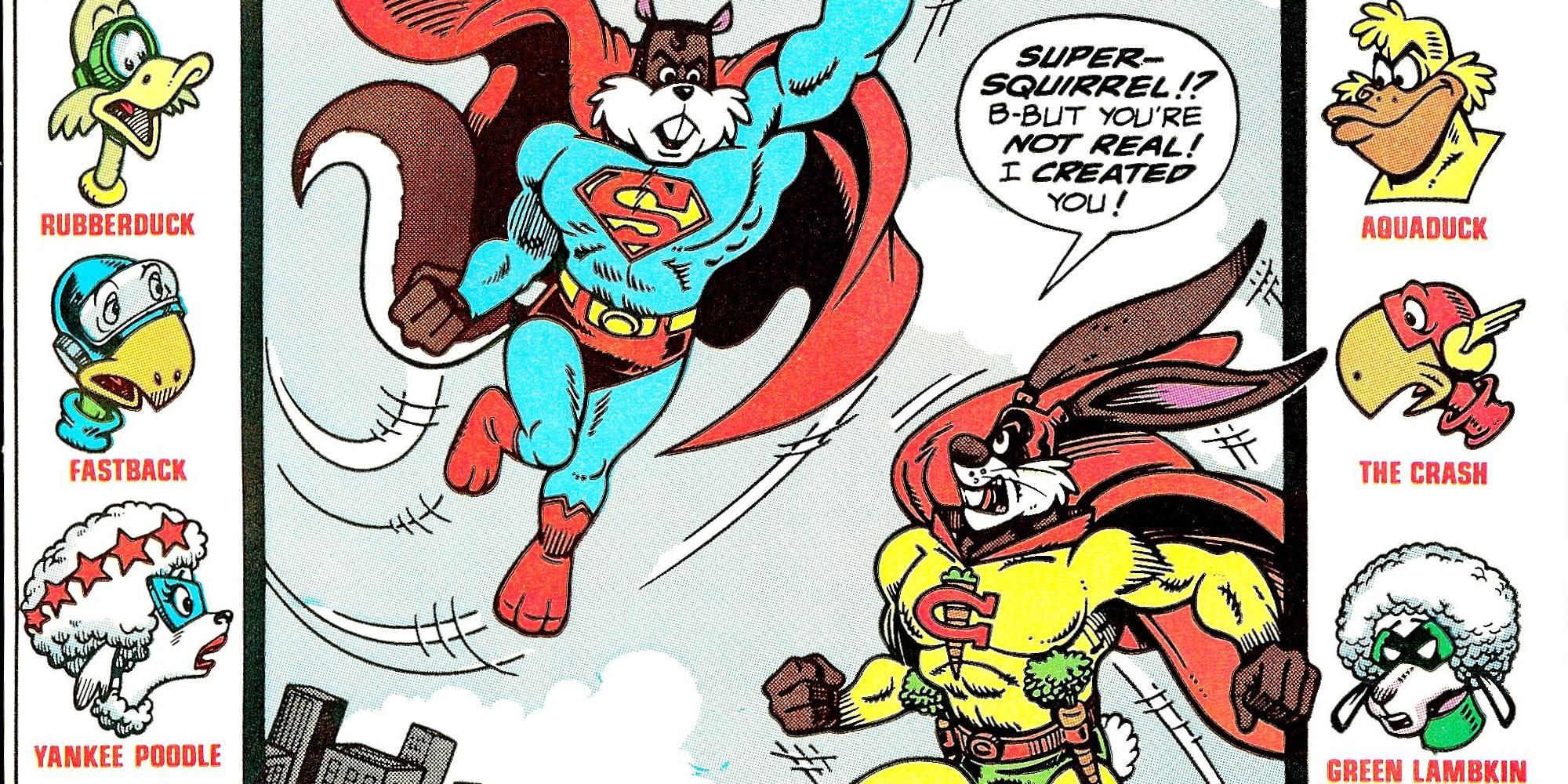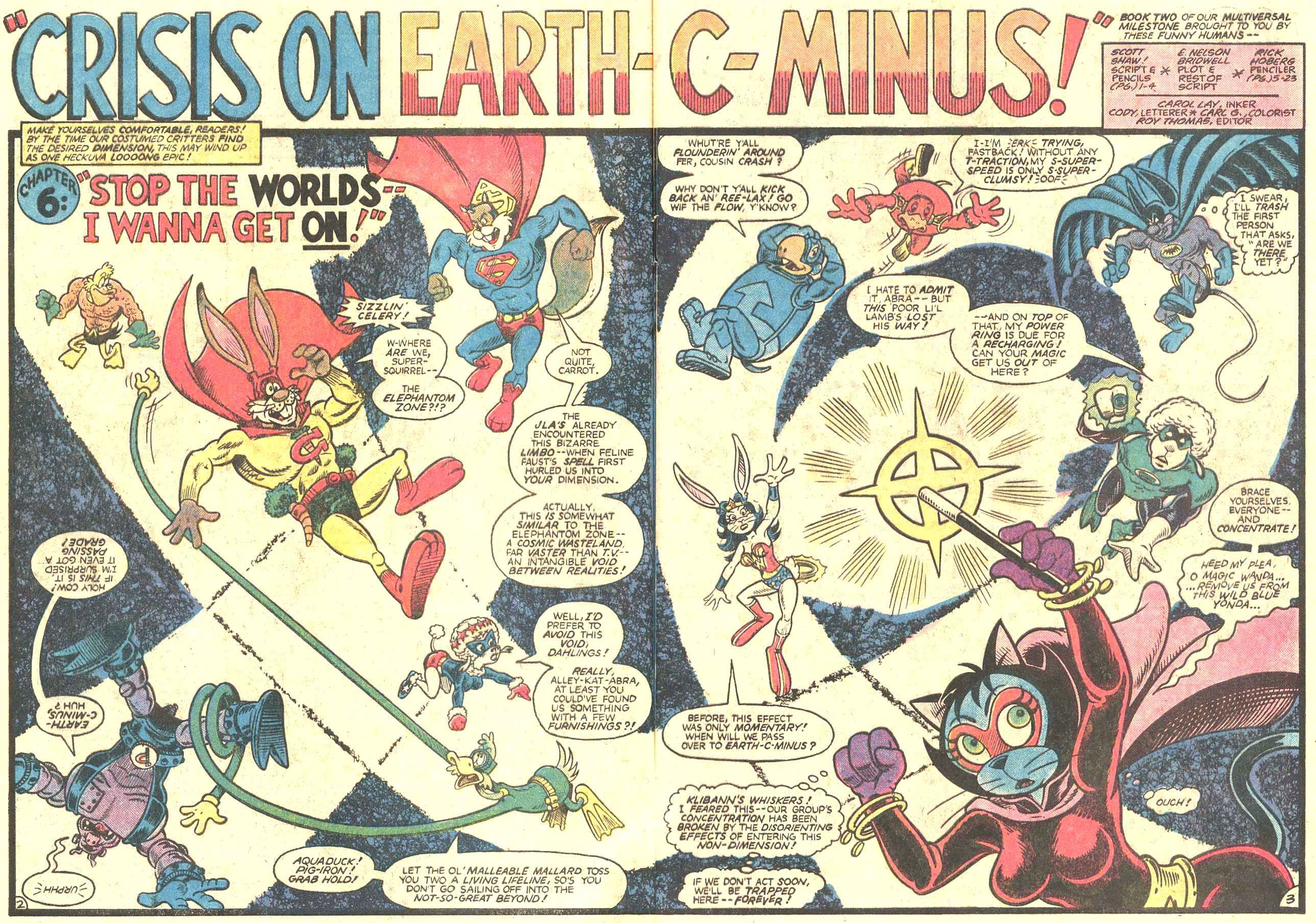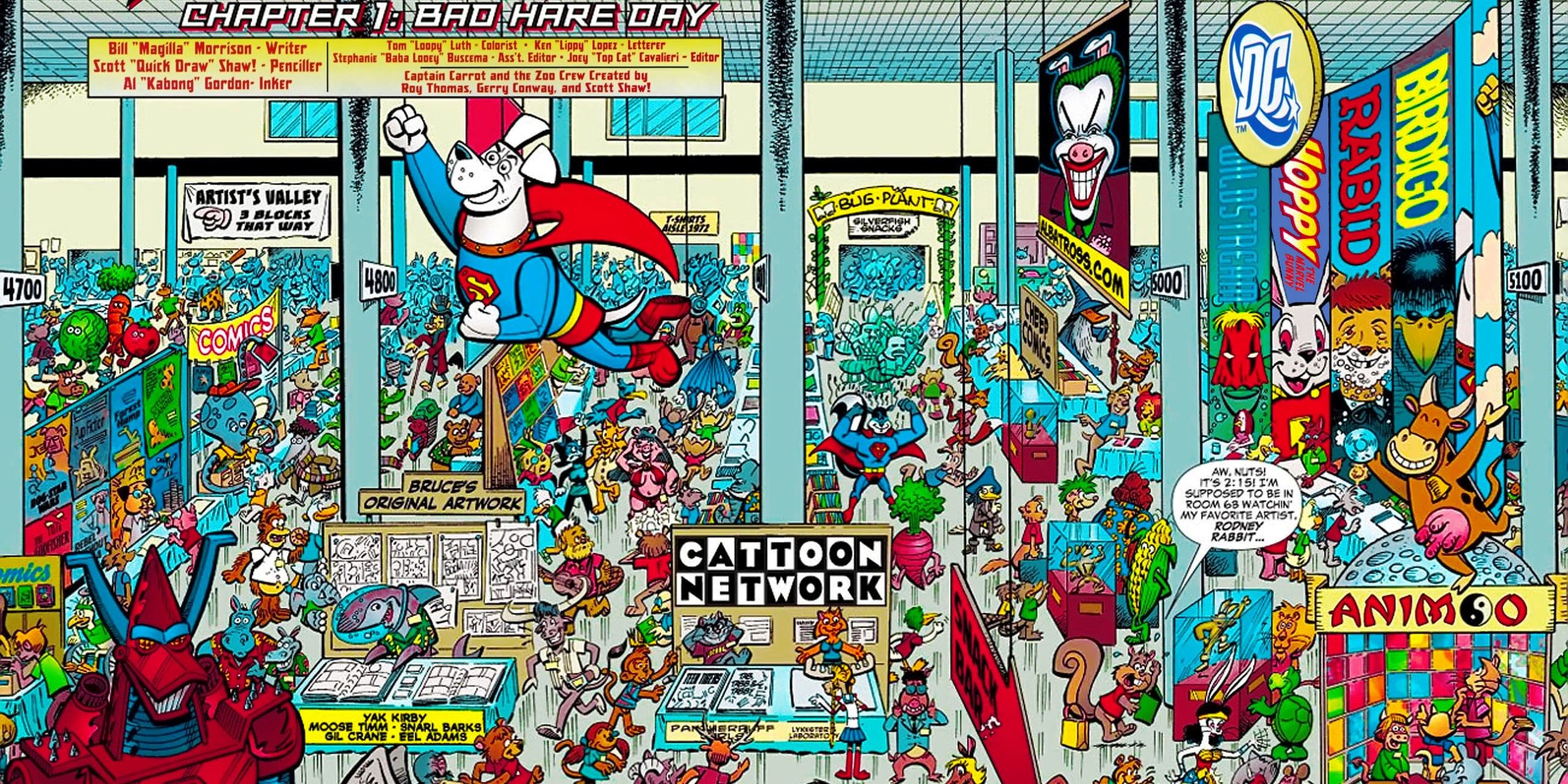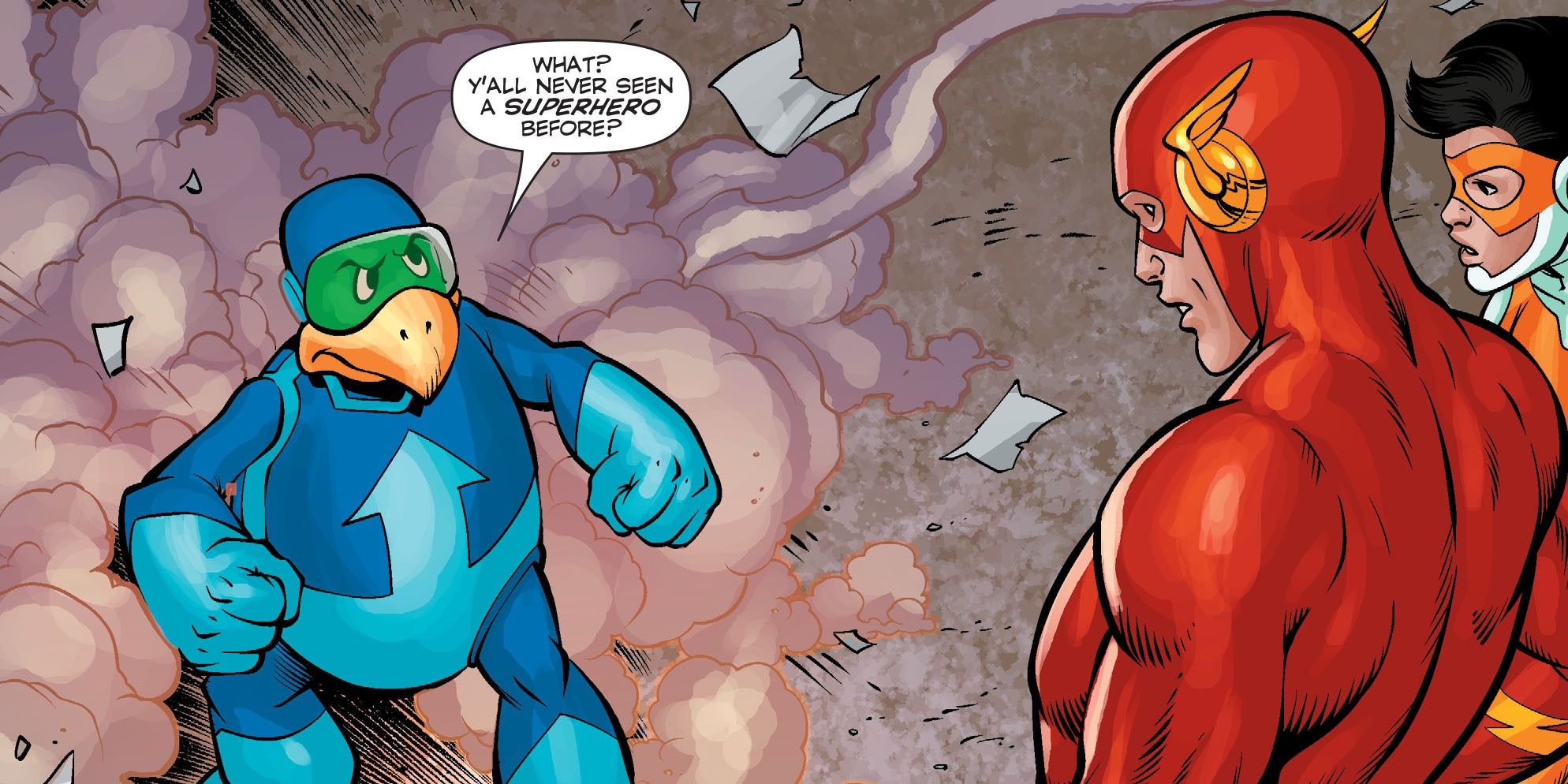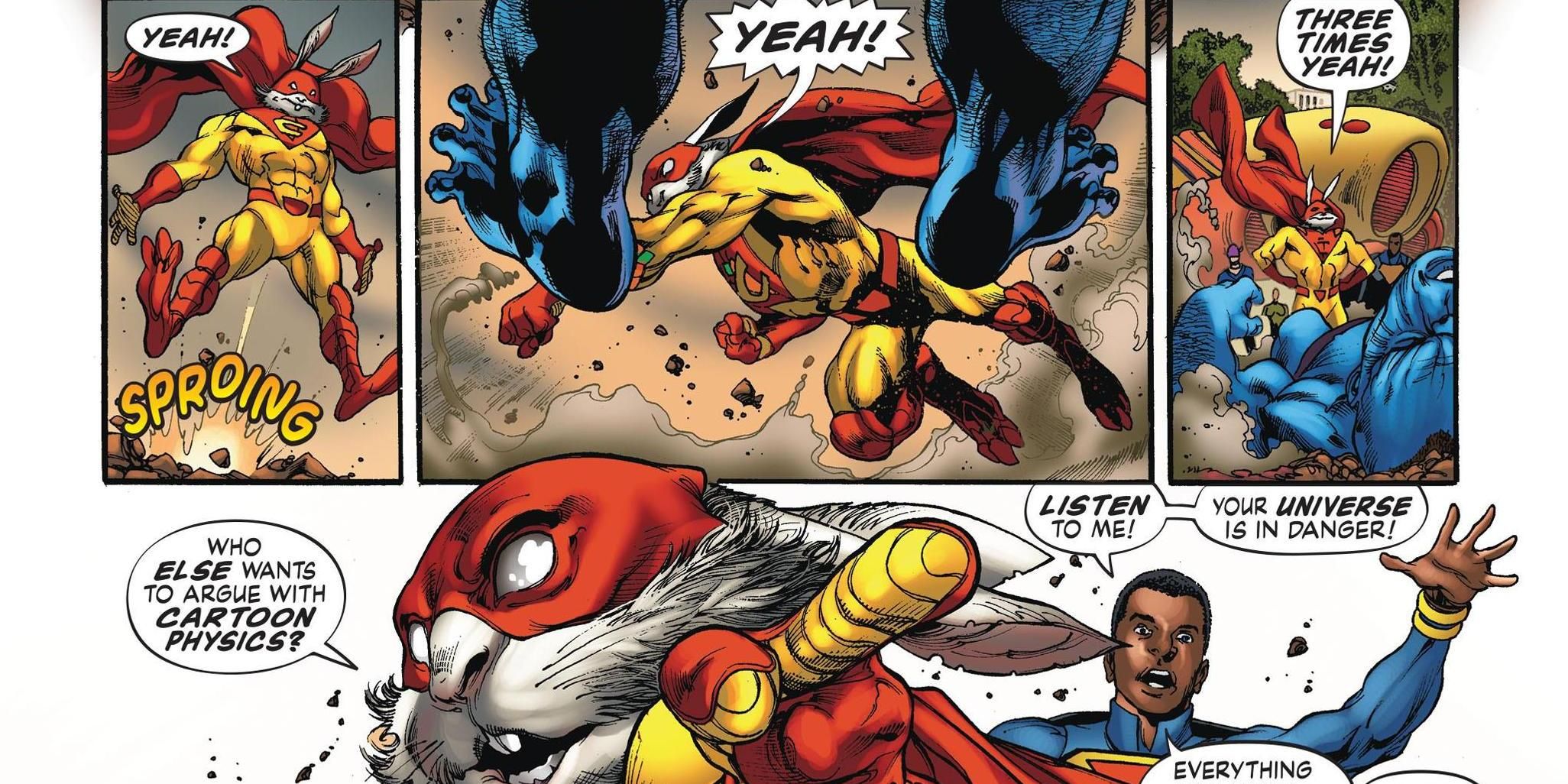As part of its current "Rebirth" initiative, DC Comics is tweaking its superhero line with more familiar takes on A-listers like Superman and Wonder Woman. In that context, it was somewhat surprising, and fairly encouraging, to see the cartoony crusader Captain Carrot in recent issues of "Superman."
The battling bunny and his animal allies in the Zoo Crew were created by Roy Thomas, Gerry Conway and Scott Shaw! and debuted 35 years ago -- in a preview as part of February 1982's "New Teen Titans" vol. 1 #16, to be exact. Subsequently, "Captain Carrot And His Amazing Zoo Crew!" lasted a respectable 20 issues, from March 1982 to November 1983, and attracted enough of an audience for a follow-up miniseries, January-March 1986's "Oz-Wonderland Wars." After that, though, the Zoo Crew drifted into limbo, popping up here and there as -- you'll forgive the rabbit-related expression -- Easter eggs and cameos in various superhero titles from "The Kingdom" and "JLA: World Without Grown-Ups" to "Wonder Woman" and "Convergence."
The group was revived briefly for a 3-issue 2007 miniseries ("Captain Carrot and the Final Ark") which led to a 2009 "Final Crisis" cameo. While Fastback teamed up with Wally West and family in "Convergence," only Captain Carrot joined "Multiversity's" Justice Incarnate in 2014. Still, when Justice Incarnate appeared in "Superman," naturally Captain Carrot came along, providing one of the arc's more dire cliffhangers to boot. Therefore, we think now is as good a time as any for DC to take another chance on the superhero satire.
ZOO CREW REVIEW
It all began when Superman deflected a radioactive meteor through a dimensional wall -- you know, a typical Thursday -- and found himself plummeting towards the funny-animal world of Earth-C (later Earth-26). Fragments of the meteor crashed all over the United Species of America, giving a handful of its residents super-powers. In Gnu York, Roger Rodney Rabbit was just a mild-mannered cartoonist until eating meteor-irradiated veggies turned him into the super-powerful Captain Carrot. Meanwhile, in Califurnia, movie star Byrd Rentals and gossip columnist Rova Barkitt became the stretchy Rubberduck and the star-spangled Yankee Poodle. Mew Orleans had the magic-using Alley-Kat-Abra (secretly martial-arts instructor Felina Furr), while the Okey-Dokey Swamp was home to the speedster Fastback (a/k/a Timmy Joe Terrapin). The augmented animals teamed up to save the Man of Steel from Starro the Conqueror -- not coincidentally, also the villain of the Justice League's first appearance, back in "Brave and the Bold" issue #28 -- and decided to stay together on an ongoing basis.
As one might expect from a series co-created by Roy Thomas, "Captain Carrot" was grounded rather solidly in DC funny-animal history. Fastback's uncle was McSnurtle the Turtle, a/k/a the Terrific Whatzit, who first appeared in Summer 1944's "Funny Stuff" #1 and was created by Martin Naydel (not to be confused with Green Lantern co-creator Martin Nodell). The Whatzit was, appropriately enough, a super-speedy turtle who wore a toonified version of the Flash's costume. By the way, lest you think that McSnurtle has been forgotten, he's made a couple of cameo appearances on the "Flash" TV series, both as young Iris' favorite stuffed animal and as a housewarming present for Barry and Iris' new apartment.
Furthermore, the Zoo Crew's final founding member was himself a longtime DC funny-animal character named Peter Porkchops. Created by Otto Feuer and appearing first in March 1947's "Leading Comics" #23 (a series once home to the Seven Soldiers of Victory), Peter soon gained his own series in addition to the "Leading" feature. Peter stayed in "Leading" until its final issue (September 1955's issue #77), while "Peter Porkchops" ran for 62 issues (December 1949-December 1960). Thomas, Conway and Shaw! revived Peter as Pig-Iron, the hard-as-metal hulk with a Ben Grimm-esque personality. In "Captain Carrot" issue #10, Thomas, scripter E. Nelson Bridwell and penciller Stan Goldberg reintroduced Peter's old frenemy Wolfie as the "Wuz-Wolf," who could transform into a man-creature and therefore used to be ("wuz") a wolf.
Captain Carrot also had an unintentional connection to another cartoon bunny, one which forced a slight name-change. His secret identity went from "Roger Rabbit" to "Rodney Rabbit" once DC realized that writer Gary K. Wolf had already used the former for his novel Who Censored Roger Rabbit? The Disney adaptation "Who Framed Roger Rabbit?" made Captain Carrot "Rodney" forevermore.
Later, the Zoo Crew added the shrinking mouse Little Cheese, who debuted in "Captain Carrot" issue #12 and joined in #20; and the gadgeteer American Eagle, who had replaced Little Cheese by the time of "Captain Carrot's" very brief quasi-backup series in "Teen Titans" vol. 3 issues #30-31 (December 2005-January 2006).
The original "Captain Carrot" series was consistently entertaining, and certainly energetic enough to overcome a constant stream of groanworthy animal-based puns. In fact, the punning was so relentless that after a while it almost blended into the background. Otherwise, "Captain Carrot" presented the funny-animal version of standard super-team fare. As their Earth's greatest (and, for the most part, only) superheroes, the Zoo Crew fought evil geniuses like Doctor Hoot, monsters like Frogzilla and the sinister Salamandroid, and diabolical organizations like A.C.R.O.S.T.I.C. In issues #14 and #15, they even teamed up with the Just'a Lotta Animals, the "fictional" superheroes Rodney Rabbit wrote and drew, who lived, naturally, on Earth C-Minus. Along with Superman, they also met some of DC's more familiar animal-associated characters, including Starro, Hoppy the Marvel Bunny, Gorilla Grodd and Beast Boy (who at the time went by "Changeling").
Roy Thomas and Scott Shaw! stayed with the book in various capacities throughout the series' run, assisted by writers E. Nelson Bridwell and Joey Cavalieri and pencillers Stan Goldberg and Rick Hoberg. Thomas then edited the "Oz-Wonderland Wars" miniseries, which Bridwell and Cavalieri wrote and Carol Lay drew. Twenty years later, Shaw! and writer Geoff Johns brought back the Zoo Crew in "Teen Titans" for a jarringly grim tale of betrayal, depression and murder which, thankfully, the "Final Ark" miniseries did its best to reverse. However, despite being drawn by Shaw! and inker Al Gordon, and written by Bill Morrison of "Simpsons Comics," the "Final Ark" miniseries got lost amongst all the other "Countdown"-related multiversal tie-ins.
FAUNA FUNNIES
In a way "Captain Carrot" was ahead of its time, since it came and went just before a tidal wave of funny-animal super-parodies fueled the mid-1980s' black-and-white explosion. "Captain Carrot's" original run was the heyday of Marv Wolfman and George Perez's "New Teen Titans," John Byrne's "Fantastic Four" and Frank Miller's "Daredevil." A few years later, when the black-and-white explosion was in full swing, Byrne, Miller and other high-value professionals were at DC reinventing its A-listers, and the publisher didn't need or want to compete with the likes of "Adolescent Radioactive Black Belt Hamsters."
Indeed, one of those reinventions was an unabashed superhero satire, "Justice League International." Produced by plotter Keith Giffen, scripter J.M. DeMatteis, and pencillers Kevin Maguire and Ty Templeton, "JLI" not only brought the big names back to the League, it made them funny. Bob Rozakis and Stephen DeStefano's "'Mazing Man" and Kyle Baker's "Shadow" also ribbed late-1980s superhero comics; and in the '90s that job fell to Dan Raspler and Dev Madan's "Young Heroes In Love" and Mark Waid and Humberto Ramos' "Impulse." Most recently, Bat-Mite and Bizarro got six-issue miniseries as part of "DC You."
Of course, we can distinguish "Captain Carrot" from all those books with the simple fact that it starred funny animals and the others didn't. (The possible exception is "'Mazing Man," where Maze's best friend Denton -- who only looked like a cartoon dog -- drew a comic strip in which the dog sidekick became cosmically aware that he was in a comic strip.) We might even postulate that it's harder to do good satire with funny animals because their inherent "cuteness" presents an extra degree of difficulty.
While the comedy in "JLI" and its peers and successors came from everyman characters reacting to a fantastic world (or vice versa), in "Captain Carrot," both the characters and the world were over-the-top. Therefore, a "Captain Carrot" revival might have to dial back the wackiness just a little in order to make its cast and/or their surroundings more accessible. The "Final Ark" miniseries did this to a certain extent, but eventually the Just'a Lotta Animals were meeting a group of New Dogs on the trail of Barkseid and ... you get the idea. To be fair, the "Teen Titans" stories went out of their way to deconstruct the world of Earth-26 almost in an Alan Moore-esque fashion. If those stories did nothing else, they showed that "Captain Carrot" needs its goofiness to keep that super-serious tone at bay.
RABBIT RENAISSANCE
Besides, we think "Unbeatable Squirrel Girl" and "Flintstones" (as well as the just-concluded "Howard the Duck") demonstrate that there's room in the current superhero marketplace for series which are wacky on the outside but smart and heartfelt underneath. Each has a slightly different approach: Howard started out jaded and hasn't mellowed much; while Doreen Green's more cheery perspective fuels her firm commitment to superheroing. Since the Zoo Crew are more middle-of-the-road characters, perhaps it would be easiest for a new "Captain Carrot" to emulate "Flintstones" by leaning into its unique setting as "Flintstones" has. It wouldn't have to follow "Flintstones" completely, though. Although the success of "Flintstones" comes from its willingness to take on modern social issues, Captain Carrot doesn't need to get much more "realistic."
Prior to "Multiversity," DC did try, in a roundabout way, to bring back Captain Carrot. In the short-lived 2013 series "Threshold," writer Keith Giffen and artist Tom Raney reimagined him as K'Rot, captain of a very small space-pirate band which also included a mate named Pig-Iron. Neither was from Earth-26, since both operated in the far reaches of the DC Universe. Needless to say, the reimaginings didn't take; and "Threshold" lasted only eight issues.
However, when writer Grant Morrison and penciller Ivan Reis reintroduced Captain Carrot via "Multiversity," they also made him more hard-boiled (and less cartoony) than Rodney Rabbit had been. This Captain Carrot not only remembered his early encounter with Superman, he knew his way around the Orrery of Worlds and could take advantage of "cartoon physics." It wasn't a total makeover, and it was far from the drastic tonal shift of the "Teen Titans" stories. A new "Captain Carrot" series could do worse than starting with this version.
A revived "Captain Carrot" might also look to another "Multiversity" adventure, specifically "Thunderworld's" traditional take on the Marvel Family. For years DC has struggled with how to present the hyper-wholesome Marvels alongside characters who aspired to be taken seriously, and for years DC has erred on the side of trying to have the Marvels -- or, as they're now known, the "Shazam Family" -- taken seriously. Clearly a big part of the Zoo Crew's appeal is that they cannot possibly be taken seriously; but that doesn't mean they can't be entertaining. On its surface "Captain Carrot" is inherently silly, and any attempt to mitigate that is both misguided and doomed.
What "Captain Carrot" can do is point out how superhero fare in general is both silly and entertaining (in varying amounts, of course). As much as "Rebirth" has sought to make DC's superhero line more fun, its main source of wackiness is the blackly-comic "Harley Quinn." Zoo Crew characterization never ran very deep, but that's not necessarily an excuse to have them suddenly driven by personal tragedies. Thus, a new -- and presumably more light-hearted -- "Captain Carrot" wouldn't be redundant next to "Harley," and could even complement "Harley's" tone. Heck, with the sitcom "Powerless" DC has shown it's willing to laugh at itself.
At the very least, Captain Carrot and the Zoo Crew are overdue for more exposure across the wider DC line. In addition to Captain Carrot's appearances with Justice Incarnate, the group could team up with Scooby-Doo, and would be ideal for the Art Baltazar & Franco treatment. Finding a good creative team is key, of course. Marvel didn't just bring back Howard the Duck and Squirrel Girl, it paired Howard with Chip Zdarsky and Joe Quiñones and SG with Ryan North and Erica Henderson.
"Captain Carrot's" premise is deceptively simple, but adaptable to a wide range of stories and formats. Thanks to "Multiversity," the Zoo Crew can team up with everyone from Earth-0's Superman and Batman to Earth-29's Bizarros, Earth-47's Love Syndicate or Earth-5's Marvel Family. A new series could also stay outside the main superhero line, as "Flintstones" and "Prez" have; or could go squarely for the all-ages crowd in the vein of "Tiny Titans" and "Super Powers."
Whatever DC decides to do with "Captain Carrot" -- even if it's just the occasional Zoo Crew guest-shot -- we do have one last request. We know that by now Rodney Rabbit is a veteran cartoonist, but please make sure that his next Earth-26 gig is with that hip new imprint Young Animal. It's like they were made for each other!

